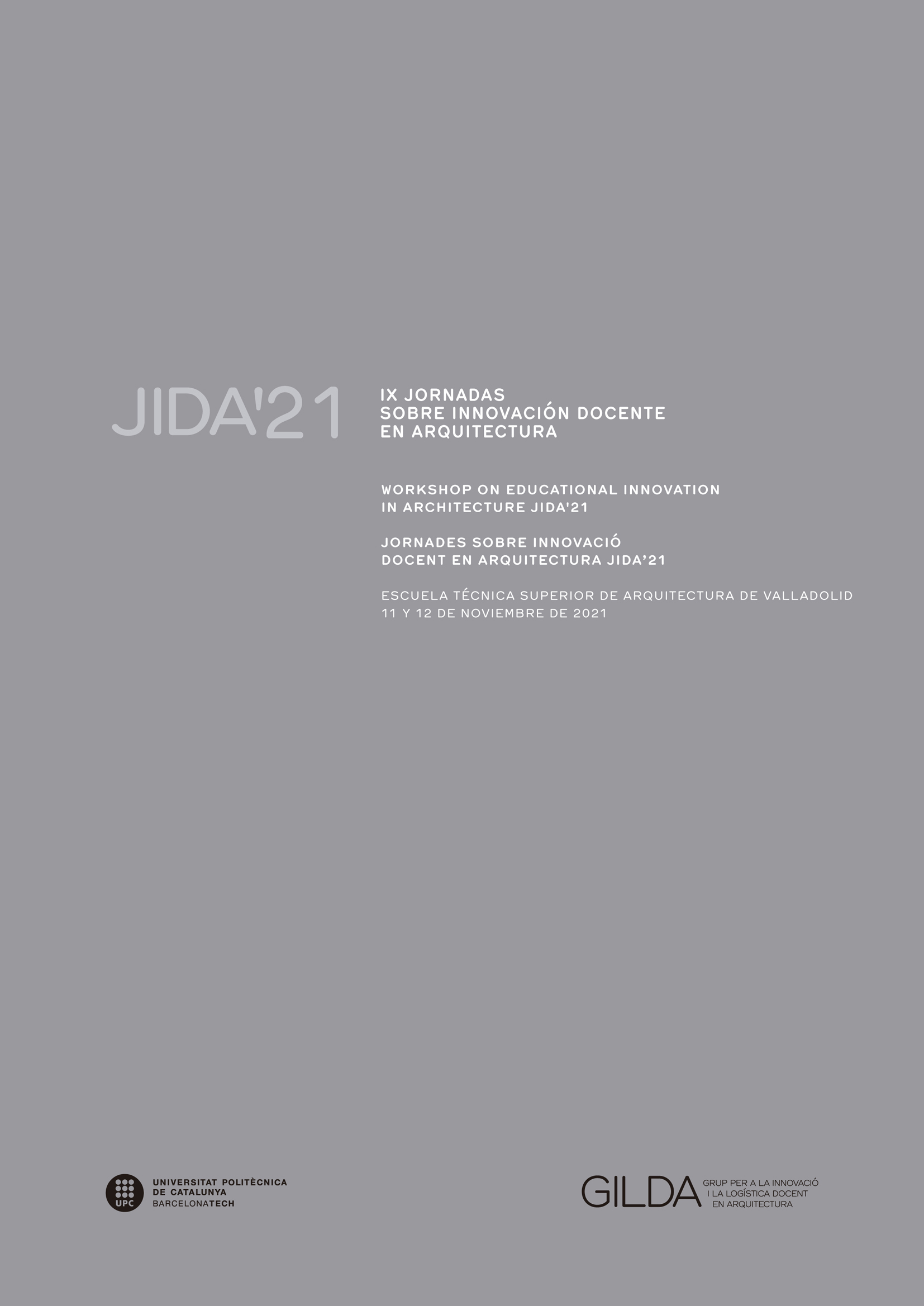Animation techniques for understanding and storytelling of construction assembly processes
DOI:
https://doi.org/10.5821/jida.2021.10450Keywords:
architectural constructions, assembly processes, animation techniques, gamification, teaching innovationAbstract
The inclusion of ICT in university teaching in the Degree in Architecture as well as the huge amount of information from various fields that students handle can divert the focus of attention from the general and basic skills that an architect must have in terms of the construction of a building. Through this article, it is proposed to show
the use of a simple and free animation tool that helps to generate the assembly of architectural projects and a better understanding of all the variables associated with
these construction assembly processes. In this way, it is possible to combine all the disciplines in one thanks to a "virtual execution of a work" that will anticipate the
proper use of more complex collaborative tools, will facilitate the acquisition of important skills for professional life and will avoid failures in the development or
errors in execution.
References
ABDIRAD, H. y DOSSICK, C.S. (2016). “BIM curriculum design in architecture, engineering, and construction education: a systematic review” en Journal of Information Technology in Construction, vol. 21, p. 250-271.
ALVARADO, R.; LAGOS, R.; SALCEDO, P.; RAMOS, M.; LABARCA, C.; y BRUSCATO, U. (2009). “Emociones precisas: fabricación digital en la enseñanza de la arquitectura” en Arquitetura Revista vol. 5, issue 2, p. 122-136.
ARRIBAS, R. (2016). “Jean Prouvé y Konrad Waschmann. Dos formas de utilizar la maqueta como herramienta de proyecto” en Proyecto, Progreso y Arquitectura vol.15, p. 56-69.
BRAVO, M. (2015). “Emergent digital design strategies in Architecture: tools and methodologies” en JIDA’15. III Jornadas de Innovación Docente en Arquitectura. Barcelona. Disponible en <http://hdl.handle.net/2117/88119> [Consulta: 5 de junio de 2021].
CASSINELLO, P. (2008). “Eduardo Torroja y la industrialización de la “machine à habiter” 1949-1961” en Informes de la Construcción, vol. 60, issue 512, p. 5-18.
GÓNZALEZ, J.L. y CASALS, A. (2001). “Las estrategias docentes de la construcción arquitectónica” en Informes de la Construcción, vol. 53, issue 474, p. 5-19.
JORGE, C. (2016). “La aplicación de stop-motion en arquitectura: materia y luz” en Innovación e Investigación en Arquitectura y Territorio, vol. 4, issue 1, p. 1-15. Disponible en <https://doi.org/10.14198/i2.2016.4.03> [Consulta: 15 de abril de 2021].
KOCATURK, T. y KIVINIEMI, A. (2013). “Challenges of Integrating BIM in Architectural Education” en 31st eCAADe Conference. Delft, The Netherlands. Disponible en <https://livrepository.liverpool.ac.uk/2007736/> [Consulta: 10 de mayo de 2021].
LABARTA, C. (2015). “La docencia no reglada: el valor de la actitud en el aprendizaje del proyecto arquitectónico” en JIDA´15. III Jornadas de Innovación Docente en Arquitectura. Barcelona. Disponible en <https://dialnet.unirioja.es/servlet/articulo?codigo=6951609> [Consulta: 3 de mayo de 2021].
MACIÁ, M.E. (2019). “Aprendiendo a construir cubiertas convencionales en arquitectura con Stopmotion”. Congreso para la Difusión de la Producción Científica e Innovadora CODIPROCIN.
MAIA, L.; MEDA, P.; y FREITAS, J. (2015). “BIM methodology, a new approach - case study of structural elements creation” en Procedia Engineering, vol. 114, p. 816-823.
PÉREZ, S. (2009). “Industrializar” en Informes de la Construcción, vol. 61, issue 513, p.5-10.
PONS-VALLADARES, O.; GONZÁLEZ-BARROSO, J.M.; LÓPEZ-OLIVARES, R.; y ARIAS, I. (2015). “Educational Project to Improve Problem-Based Learning in Architectural Construction Courses Using Active and Co-operative Techniques” en Revista de la Construcción, vol. 14, issue 2, p. 35-43.
RUIZ-BALLESTA, A. (2013). El uso del Stop Motion como medio para potenciar y desarrollar las capacidades del alumnado. Trabajo Final de Máster. Universidad internacional de la Rioja. Disponible en <https://reunir.unir.net/handle/123456789/1272> [Consulta: 16 de junio de 2021].
SALAS, J. (2008). “De los sistemas de prefabricación cerrada a la industrialización sutil de la edificación: algunas claves del cambio tecnológico” en Informes de la Construcción, vol. 60, issue 512, p.19-34.
SANTAMARINA-MACHO, C. (2017). “Náufragos digitales en la enseñanza arquitectónica” en JIDA´17. V Jornadas de Innovación Docente en Arquitectura. Sevilla. Disponible en <http://hdl.handle.net/2117/109579> [Consulta: 8 de abril de 2021].
SETAREH, M. (2001). “Development of teaching tool for building construction” en Journal of Architectural Engineering, vol 7, issue 1, p. 6-12.
TOPCU, U.; TABERNA, J.; y HOFERT, K. (2015). “A visual tale of two cities: video as a tool for representation through informal learning” en JIDA´15. III Jornadas de Innovación Docente en Arquitectura. Barcelona. Disponible en <http://hdl.handle.net/2117/79546> [Consulta: 20 de junio de 2021].
VILAMAJOR, M. y ESTEVE, F.M. (2016). “Dispositivos móviles y aprendizaje cooperativo: diseño de una intervención con dispositivos móviles en un entorno de aprendizaje colaborativo en la etapa de educación primaria” en EDUTEC, Revista electrónica de Tecnología Educativa, vol. 58.



















